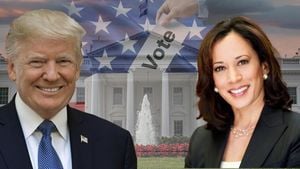With Donald Trump now back in the political spotlight following the recent elections, all eyes are on his proposed economic policies and their potential ramifications for the U.S. economy and global markets. One of the most hotly debated parts of his economic agenda is the introduction of universal tariffs, which many fear could reignite inflationary pressures just as they appear to be moderATING.
Trump's plan reportedly includes sweeping tariffs across the board, with ambitious hikes proposed on imports from other countries, particularly eyeing China with tariffs as aggressive as 60%. Such measures have raised alarm bells among economists and market analysts, who are wary of the repercussions these policies could have on inflation rates already reeling from external pressures.
"If there's a tit-for-tat retaliation from global trade partners, it becomes concerning and increases uncertainty," warned Neel Kashkari, the President of the Federal Reserve Bank of Minneapolis. His comments resonate with those who experienced the turbulence of the U.S.-China trade war instigated during Trump's previous administration, where retaliatory measures only exacerbated market volatility and inflationary trends.
But Trump's supporters and some financial analysts see potential opportunities. Emerging markets, particularly those with improving fundamentals—like Argentina, Sri Lanka, and Pakistan—are beginning to lure investors who hope to find refuge from the expected chaos. These countries have yielded significant returns this year, with some debt instruments delivering over 23% returns, giving hope amid the uncertainty of Trump's second term and the potential for inflation to spike.
According to Shamaila Khan, who leads fixed income for UBS Asset Management, "Fundamentals are improving. Countries coming out of default can continue to deliver attractive double-digit returns." Such optimism paints a stark picture against the backdrop of Trump's tariff plans, which many believe could hinder global trade and lead to rising costs for consumers.
Meanwhile, not everyone is convinced the chaos is worth the risk. Economists warn against the detrimental impacts of introducing high tariffs, especially when many are still grappling with the inflationary aftermath of the previous economic policies. Larry Summers, a former Treasury Secretary, emphasized the pitfalls of inflation for vulnerable populations, noting its long-term damaging effects on the economy.
"The existence of these policies may create confusion among voters, who could directly link escalated prices to the administration's tariffs," suggests Neil Irwin, writing for Axios. Unquestionably, the economic climate is fragile, and how Trump maneuvers these policies could significantly sway public opinion, potentially spurring voter discontent.
Considering both Trump's economic strategy and the broader view of recovery, there’s no denying the speed of recovery after the initial fallout of pandemic-induced shutdowns. Advocates of these economic policies argue they may have aided recovery, sparking growth even amid historically high inflation rates. Recent data suggest the U.S. recovery was rather swift compared to other developed countries, showcasing how fiscal stimulus—though controversial—was also pivotal. The American Rescue Plan (ARP), for example, initially appeared to bolster economic performance by distributing over $1,300 to families and injecting funds directly to states.
Yet, this rapid recovery came with its consequences. Experts pinpointed the substantial inflationary impact tied to this fiscal stimulus, driving prices up across the board. It may well be the case, as noted by the San Francisco Fed, the fiscal actions accounted for about 3% of the inflation witnessed last year. Now, the lasting effects of these policies linger, with prices still elevated, compelling Americans to contend with budgets stretched thinner than ever.
Politically, some argue this could hand Trump ammunition to criticize his opponents, emphasizing the perceived economic pain linked to Democratic leadership. Observations from the electoral arena highlight how inflation has historically swayed voters, and the linkage of rising prices to political decisions can have outsized impacts, as seen with Nixon and Reagan during past economic turmoil.
Given the uncertainty swirling around Trump's anticipated policies, strategic moves are being made across the financial spectrum, with investors bracing for potential market disruptions. Analysts suggest high-risk instruments may flourish under these conditions, at least until the dust settles and true impacts become clear.
High-yield corporate bonds, for example, remain appealing amid the flux, providing attractive returns compared to government-backed securities. Eric Fine, head of Emerging Markets Active Debt at VanEck Associates, encourages investors to remain optimistic, stating, "High-yield corporates are more of a high-yield play, as opposed to the Treasury trade. They pay you more for the risk you take." This sentiment reflects the reality many investors face—finding value amid volatility.
Yet, some investors are treading carefully, tuning their strategies to mitigate potential risks associated with geopolitical upheaval, particularly with new tariffs threatening economic dynamics. Concerns loom over higher U.S. borrowing costs and how tighter financial conditions could put pressure on developing nations and limit their ability to ride out inevitable storms.
Markets are already responding, with some currencies collapsing and others rebounding post-election. While portfolios are being realigned, caution remains key as Trump’s administration begins to solidify its stance and roll out its policy agenda. Investors will have to stay vigilant, adjusting their strategies as the economic environment shifts swiftly.
Looking forward, analysts anticipate upcoming economic indicators will paint the financial outlook with clearer colors. Upcoming interest rate decisions and inflation data will serve as focal points for the markets, clarifying the Federal Reserve's response to Trump’s policies and how they’ll navigate the tumultuous waters of global trade.
With all eyes on the potential for change, traders and policymakers are poised to react not only to Trump's moves but also to any counteractions from global partners. The coming months could reshape the economic fabric as we know it, echoing old lessons learned from past confrontations and setting the stage for future financial trends. Stay tuned as the story continues to evolve.



